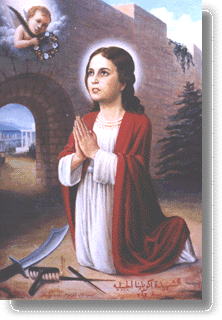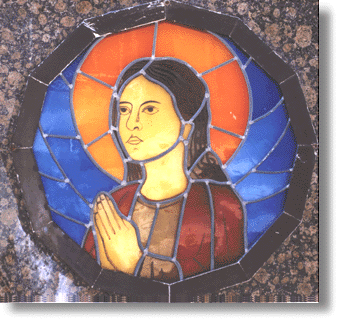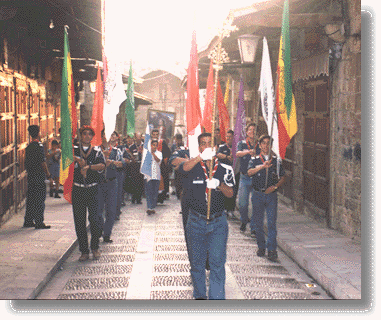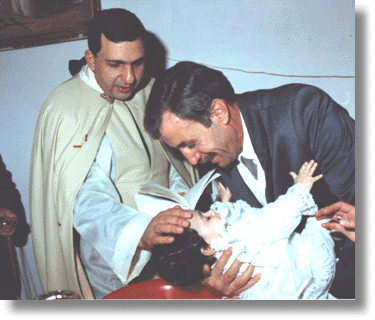Lebanon (281-293 A.D.) PART II By Guita G. Hourani
This is Part II of three devoted to the martyrology of Saint Aquilina, Part I, which appeared in the Journal of Maronite Studies, Vol. 3, Issue 2, April 1999, described Aquilina's passion and martyrdom and made available for the first time the holy canon (hymn) of Saint Joseph the Hymnographer. Part II, presented here, describes Aquilina's icons, the current devotion to her and recent miracles or miraculous events. Special acknowledgment is due Mr. Shehadeh Boutros Al 'Etayek for his assistance in the field research and for his, and to Mrs. Georgette Chamoun for giving us an interview and permitting us to print her narrative. The conclusion, Part III, will discuss Saint Aquilina’s ancient sanctuary and her new Shrine in Byblos. As the writer of these articles, I have tried to find other sanctuaries, shrines, churches, icons, hymns, etc. dedicated to Saint Aquilina, but I did not succeed. If you, the reader, know of an ancient or modern location other than Byblos where the Saint is revered and where there are or were temples dedicated to her, please write to me so that we may share the information with our readers. I. Introduction Byblos, one of the most ancient cities on earth, is more than 7,000 years old. Remnants of civilizations from the Stone Age to the Mamluke era make Byblos one of the richest archeological areas in the world. (See Ernest Renan, Pierre Montet, and Marurice Dunand). A famous city of Phoenicia, Byblos was evangelized as early as the time of the Apostles. Its location on the way from Jerusalem to Antioch, the route traveled by the Apostles, facilitated its conversion to Christianity (Cheikho 1924: 12; Khalaf 1985: 299-304). According to Church tradition, Apostle John Mark the Evangelist was Byblos' first bishop between 44 and 68 A.D. (Janin 1938: col. 1453). This tradition is not well documented. However, we have evidence that in the third century Byblos had a bishop by the name of Evthalios who baptized Saint Aquilina (Sauma 1994: 89-90). We also know that the following bishops participated in the Church Councils as bishops of Byblos -- Basilides in the Council of Constantinople in 381, Benetius in the Council of Antioch in 445, Rufinus in the Council of Chalcedon in 451, and Theodore in the Fifth Ecumenical Council in 553. (Janin 1938: col. 1453 and Cheikho 1924: 13) Like the rest of their brethren, the Christians of Byblos suffered the Roman Empire's cruelty and persecution. One of the victims was Aquilina. She was 12 years old in 293 A.D. when she continued to preach about Christianity and refused to offer oblations to the gods. She was martyred and buried in her town, Byblos. (Sauma 1994: 89-90) News of her sanctity spread throughout the region and reached Constantinople, where some of her relics were taken and placed in a basilica near the Forum of Constantine, in the Philoxene quarter but this great church was later destroyed in a fire in 532 (Aigrain: 1924: 1143). II. Sainthood In the Early Church, there was no formal process for declaring a person a saint. The Bible called "saints, all the first Christians because they had a direct and constant relationship with God" (Rom 1:7; 1 Cor. 1:2; and Col. 1:2) (Urech 1973: 162). The Early Church regarded as "saints" all those Christians who were consecrated to God and sanctified by Him.… ( Fremy 1975: 391 b) Prior to the Middle Ages, revering and venerating someone as a saint was accomplished by the "voice of the people" and then consecrated by the local bishop. From the XIII to XVI centuries, the Pope himself carried the "voice of the people", "vox populi", which led to the proclaiming of saints. Today and since 1588, all beatification and canonization procedures are consigned to the authority of the Congregation for the Causes of Saints, which was instituted by Pope Sixtus in 1588. (See Divinus Perfectionis Magister by Pope John Paul II) The current canonical procedures for beatification and canonization are described in detail in the Apostolic Constitution, 'Divinus Perfectionis Magister’, promulgated by Pope John Paul II on January 25, 1983. According to these procedures, there are three steps to sainthood: one becomes Venerable, then Blessed and finally a Saint. Venerable is the title given to a deceased person recognized as having lived heroic virtues. To be recognized as blessed, and therefore beatified, one miracle acquired through the individual's intercession is required, even while the attributes of personal charity and heroic virtue exist. For canonization, the two first steps and the occurrence of a miracle after the beatification are required, though the Pope may waive these requirements. Sainthood through martyrdom does not usually require a miracle. Saints are venerated by the universal Church and the "blesseds" or the "beatified" are revered by the local Church. Martyrs are those who die in defense of the faith. (Urech 1973: 162) Many saints of the Early Church were recognized by the Holy See as saints of the Universal Church. Their existence has been affirmed and hagiographers [biographers of the saints] have established with certitude the basis for their cult or veneration. Many of these saints may have originated in Lebanon, were martyred or have been particularly venerated there. Aquilina, the Martyr Saint of Byblos, is among these saints who originated in or were martyred and are venerated in Lebanon. Aquilina's martyrology has been affirmed by the Church because her passion contains more elements of history than of legend. It is difficult to find the precise reason why devotion to a saint from early Christian times may have ceased. However, one can believe the reason to be either the natural destruction of the saint's sanctuary, the appearance of a contemporaneous saint(s), the preference of the missionaries for one saint over another, or the advance of Islam. We know that Byblos itself suffered three major earthquakes in 526, 528 and 554. There was as well the Muslim oppression after the retreat of the Crusaders toward the end of the XIII century (Janin 1938: col. 1452). Aquilina's veneration however, has survived the ages, although it has known growth at times and has experienced setbacks at others. Today, homage to her has been renewed and devotion to her is increasing. III. Iconography "An icon is a prayer in line and form; a hymn of praise in color and harmony, a work of beauty inspired by God, an offering of the soul, painted to adorn the Church. It illustrates the words of the Gospel, is faithful to apostolic teachings, and follows the traditions of the Church. It speaks to the heart and soul of the faithful, is a window into Heaven, and lifts us up to Christ and the Saints. An icon belongs to the liturgical worship of the Church. While it embodies eternity, it brings Heaven to earth" (Maronite Icons 1999: xiv). An icon aims at capturing not the natural look of the person or things depicted, but their spiritual essence through the choice of color, facial expression, body posture and position, and composition. An icon is a symbolic representation that tells the story of the Saint's life. This representation is written in a special language. In essence, every element and detail in the icon- color, lines, position, secondary figures, plants, animals or objects- are part of this language and have symbolic meaning based upon the Scriptures, theological sources, hagiographies, and the teaching of the Church Fathers. Kissing an icon, lighting a candle before it, or making the sign of the cross and praying before it should not be regarded as worshiping idols. These gestures are not made to the actual picture itself, rather they go beyond the icon to the person depicted in it . Aquilina's icons are made and venerated in this spirit. Three main icons or religious art representations of the Saint are currently
known. The first is the painting adorning her ancient sanctuary and the
new Shrine in Byblos. The second is a photo of a previous portrait found
in the possession of Father Antonios Chaïna, resident hermit of Mar Boula
Hermitage of Saint Anthony the Great of Qozhayya Monastery in the Holy
Valley of Saints in Lebanon (Wadi Qadisha). The third is a stained glass
portrait displayed in a sidewalk shrine on Aquilina Street in Byblos.
The angel is the messenger, the ambassador of God. The crown is to consecrate
her to God. It is the crown of glory, victory, virtue, and martyrdom. Aquilina's
head is wreathed in a halo, the symbol of sainthood and special relation
with the Divine.
The Municipality of Byblos, in its meeting on August 28, 1987, unanimously
approved the request. Decision No 117 of August 28, 1987, stated the following:
Once the street had been named and approved by the Ministry of Interior, a small sidewalk shrine for the Saint was inaugurated and work to build a permanent Shrine in her honor began. V. Aquilina's Feast Day
Then come the deacons and ushers who carry the burning censors, filling the air with incense. The celebrants, the choir and the faithful follow while chanting the litany of Saint Aquilina. The procession ends with a celebration of the Liturgy outside the Saint's Shrine. The main celebrant recalls Aquilina's passion and asks her intercession for the citizens of the Byblos, the carrier of her name; and asks for the intercession of all the martyrs, especially those of our present time. VI. Miracles Attained wrought by God through Saint Aquilina's Intercession Between man and God there is constant communication through prayer. Through prayer, man speaks to God and appeals to Him. In some instances, God may respond to the prayer and work a miracle. Miracles are unusual, supernatural acts of God that enable us to understand theological teachings. These miracles, although they may not be directly performed by God, must be ascribed to Him because He works miracles through instruments such as angels, saints, holy images and holy places. The benefits of these miracles may be physical or temporal, but they are of great spiritual value. We know about miracles either from personal observation or from the testimony of others. The observer and/or the narrator must tell the truth. In this event, the church's role is to investigate the miracle and to accept or reject it. Keeping the above explanation in mind, we will relate one recent miracle from God that was brought about through the power of faith and prayer by way of Saint Aquilina. Interviews with the recipients of the miracle are the basis of the story. Georgette Lebbos is married to George Chamoun. They are both from Sareene in the Bekaa Vstreet. In 1993, the young couple moved to Byblos and rented an apartment in the neighborhood of the Misfayeh, near the Zgheib neighborhood. Georgette was pregnant for the first time, knew no one there and had no family members near her. One acquaintance, the wife of her husband's colleague, lived a few blocks away. In February, while Georgette was in her eighth month of pregnancy, she felt great pain in her abdomen and back. She was afraid and called her acquaintance who in turn called the doctor. He said she was undergoing labor and sent her to the hospital. Georgette refused to go because he was not her own doctor; but the main issue was her fear of having a miscarriage. She asked her acquaintance to call her husband who was on duty as a General Security officer. He arrived after she had suffered about five hours of pain and had fallen asleep. She wept and prayed to the Blessed Mother saying "Please let me keep my baby and if you want to take my baby, take us together. I am alone in Byblos. All my family and my husband's family are in the Bekaa. I am alone, don't let anything happen to my baby." In her sleep she saw above her bed a picture of a 12-year-old child. Georgette narrates: "In my sleep, I called my husband and asked him to return the picture
to the previous tenant to whom it most probably belonged. I also asked
him if he knew who the child was but he did not know. My husband said to
forget about it until the next day. As soon as my husband left the room,
a dazzling translucent light appeared, and it enclosed me with warmth and
a great love. I forgot my fear. Then the picture changed into the real
face of a 12-year old girl. When I asked her who she was, she said that
‘I came on behalf of Christ to give you what you want’. I said, ‘You are
an angel and your light is God’s light. I am going to ask you one thing:
I want only to carry my baby to full term’. She said that she ‘will grant
me my wish but’ she asks that I should never repeat that I am alone in
Byblos. All the while, she was giving me an infinitely loving look. She
continued saying ‘I am your neighbor, I am a daughter of Byblos and whenever
you need anything ask me. My home is near yours, look for me and you will
find me.’ I woke up from my sleep and all the pain has gone. I told my
husband and confirmed to him my belief that I would carry the baby to full
term.
We walked about 150-200 meters from my home to a small sanctuary in a place called Qassoubah in the Zgheib neighborhood. A lady opened the door to the sanctuary for us and as soon as I saw the picture I fell on my knees and started sobbing. I asked the identity of the Saint in the picture and was told that her name is Aquilina, that she was from Byblos and was martyred a long time ago for her faith. Then Mrs. Matar took me to the Martyr Street near the Old Market where I saw a small roadside shrine with a stained glass picture of the same Saint. My baby was born on March 21, 1993. She is a girl and I named her Aquilina. Since then, I have spoken about my miracle to many priests and to the Superior of Saint John Mark’s Cathedral. I embarrassed them for not honoring the Saint; and with my simple way and words I woke their conscience to build a church in her honor. I asked if there were any churches for Aquilina where I could baptize my daughter, but was told that there aren't any. I told the priests that I would not baptize my daughter as long as there wasn't a church for Aquilina and that it would be their fault. Father Tannous Nehme, who was working with a group of people and clergy to build a church for the Saint, was pleased to meet me and to hear about the miracle. When a site was purchased and Saint Aquilina's icon was moved to that site before completion of the Shrine, I insisted on baptizing my daughter there. Father Nehme performed the ceremony for my daughter -- the first to be christened in Aquilina's Shrine. Since then the Shrine has been completed and we always participate in the Holy Liturgy there. I had fulfilled a promise I made to myself and the Saint. I declare that all that I say is true and I say it to glorify God and Saint Aquilina." This account is a personal interview taken by the writer of this article from Mrs. Chamoun at her house in Byblos following the Holy Liturgy for Saint Aquilina's feast on June 12, 1999 in the presence of her husband George, her daughter Aquilina now five years old, her son Sharbel, and Architect Micheline Attallah. The same account was related to many other people, including priests and monks. Although we are making this statement available to our readers, we do not presume to confirm or refute it. It should be noted that the church authorities have not yet taken any official position on this miracle or the many others that have occurred through Saint Aquilina's intercession. Believers consider Aquilina the intercessor of children. Some dentists take Aquilina as their patron Saint. VII. Conclusion Byblos is reviving devotion for its own daughter. Aquilina wants her people to remember her. She is active in her own city, answering pleas and being a messenger of God's love and compassion. Byblos, "City of Mysteries" cherishes its seven thousand years of history.
To this day it continues to charm and to enchant historians, archeologists
and travelers with its legendary past glory. Byblos is known as the place
that gave the world the alphabet, that gave Christianity the name for its
Holy Book -- The Bible, and that gave the Universal Church an adolescent
Martyr Saint named Aquilina.
Bibliography Al Batrouni-Sarah, B. and N. K. Khalifeh. Deir Sayedat al Ma'ounat, Jbeil (Byblos) 1770-1995. (In Arabic), Ghazir, Lebanon: Manshourat al Yubeel al Mi'awi al Sales lil Ruhbania al Lubnaniya al Marouniyat #10, 1995. Cheikho, L. Jubeil: Tarikhuha, Adyanuha, Asaruha. (In Arabic), Beirut: Jesuits Press, 1924. Daher, B. Al Sinxar Al Marouni. (In Arabic), Holy Spirit University: Kaslik, Lebanon, 1996. Delaney, J. Dictionary of Saints. Doubleday: New York and London, 1980. Dunan, M. Byblos. Translated by H. Tabet. Paris, 1973. Fremy, D. and M. "Quid" 1975. Editions Robert Laffont. Janin, R. Dictionnaire d’Histoire et de Géographie Ecclésiastiques, Tome X, Librairie Letouzey et Ané: Paris, 1938. Khalaf, Gh. Loubanan fi Al-Kitab Al-Moukaddass, Dar Manhal Al-Hayat: Mansourieh el-Metn, Lebanon, 1985. Maronite Archbishopric of Cyprus. The Maronite Icons: Modern Sacred Art. Dar Sader Publishers: Beirut, Lebanon, 1999. Moubarak, Y. Pentalogie Antiochienne: Domaine Maronite. Cénacle Libanais. 5 tomes, Beyrouth, 1984. R. Aigrain. Dictionnaire d'Histoire et de Géographie Ecclésiastiques. Tome III, Librairie Letouzey et Ané: Paris, 1924. Sauma, V. Sur les Pas des Saints au Liban. Beirut, 1994. The Lives of the Holy Women Martyrs. Holy Apostles Convent: Buena Vista, Colorado, 1991. Urech, E. Dictionnaire des Symboles Chrétiens. Delachaux et Niestlé: Switzerland, 1973. Zgheib Al-Jubaili, A. Al Qedissat al Shahida Al Jubeyliat Aquilina. (In Arabic), Byblos, 1993. |



